侗族介绍(英语演讲)
侗族美食英语作文

侗族美食英语作文The Dong people, an ethnic minority in China, are known for their rich cultural heritage, which includes a uniqueculinary tradition that is both diverse and flavorful. Dong cuisine is characterized by its simplicity and the use of fresh, locally sourced ingredients. Here are some of the most beloved dishes that showcase the essence of Dong cuisine:1. Dong Smoked Meat: This is a staple in Dong households. The meat, usually pork, is smoked over a fire with aromatic woods and herbs, infusing it with a smoky flavor that is both rich and complex.2. Zongzi: A traditional Chinese food made of glutinous rice stuffed with various fillings and wrapped in bamboo leaves. In the Dong region, Zongzi is often filled with sweet or savory ingredients, such as red bean paste or marinated meat.3. Dong Sour Soup: A refreshing soup that is a perfect blend of sour, spicy, and aromatic flavors. It is made with fermented vegetables and often includes a variety of herbs and spices.4. Bamboo Rice: This is a unique dish where rice is cooked inside a bamboo tube over an open fire. The result is a rice dish with a distinct bamboo fragrance and a slightly smoky flavor.5. Dong-style Tofu: Dong tofu is known for its soft texture and delicate taste. It is often served with a variety of sauces, ranging from spicy to sweet.6. Fish in Dong Sauce: Fresh fish is marinated in a sauce made from local herbs and spices, then grilled or steamed. The sauce gives the fish a tangy and slightly sweet flavor.7. Sweet Potato Wine: A traditional Dong beverage made from fermented sweet potatoes. It is a sweet and slightly alcoholic drink that is often served during festivals and celebrations.8. Dong Noodles: Handmade noodles that are thick and chewy, often served in a hearty broth with a variety of vegetables and sometimes meat.9. Dong Pickled Vegetables: A variety of vegetables are pickled in a brine solution with a mix of spices. These pickled vegetables are a common side dish and are known for their tangy and crunchy texture.10. Wild Herb Salad: A simple yet flavorful salad made with wild herbs and edible flowers found in the mountains of the Dong region. It is often dressed with a light vinaigrette.Dong cuisine is a culinary adventure that offers a taste of the region's natural bounty and cultural traditions. Each dish is a testament to the Dong people's ingenuity and their deep connection with the land. Whether you are a foodenthusiast or simply curious about new flavors, Dong cuisine is a delightful journey that is sure to satisfy your palate.。
通道侗族风俗550字作文
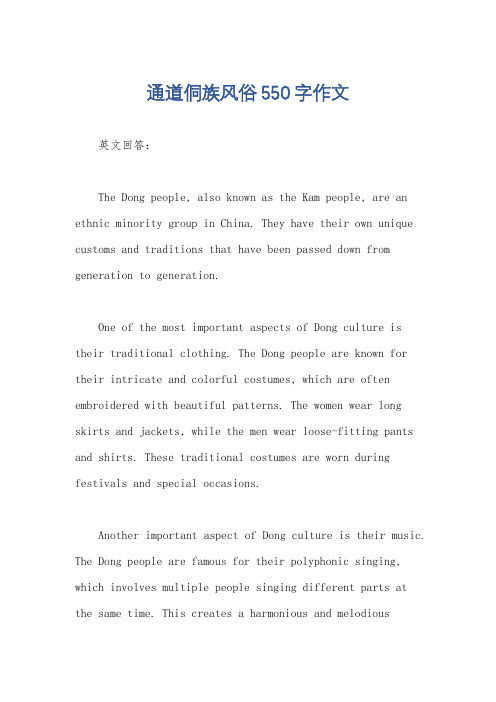
通道侗族风俗550字作文英文回答:The Dong people, also known as the Kam people, are an ethnic minority group in China. They have their own unique customs and traditions that have been passed down from generation to generation.One of the most important aspects of Dong culture is their traditional clothing. The Dong people are known for their intricate and colorful costumes, which are often embroidered with beautiful patterns. The women wear long skirts and jackets, while the men wear loose-fitting pants and shirts. These traditional costumes are worn during festivals and special occasions.Another important aspect of Dong culture is their music. The Dong people are famous for their polyphonic singing, which involves multiple people singing different parts at the same time. This creates a harmonious and melodioussound that is truly unique. The Dong people also play a variety of musical instruments, such as the lusheng, a reed pipe instrument, and the suona, a double-reed wind instrument.The Dong people also have their own unique festivals and celebrations. One of the most important festivals is the "Lusheng Festival," which is held in autumn. Duringthis festival, the Dong people gather together to play music, dance, and sing. They also participate in various traditional activities, such as bullfighting and horse racing. It is a time for the community to come together and celebrate their culture.In addition to their festivals, the Dong people also have their own unique customs and rituals. For example, when a Dong person gets married, they have a tradition called "stealing the bride." This involves the groom and his friends sneaking into the bride's house to "steal" her. The bride's family then chases after them, and if they are caught, they must pay a ransom to get the bride back. It is a fun and lighthearted tradition that symbolizes the unityof the two families.中文回答:侗族,也被称为苗族,是中国的一个少数民族群体。
有关侗族大歌的英语作文素材
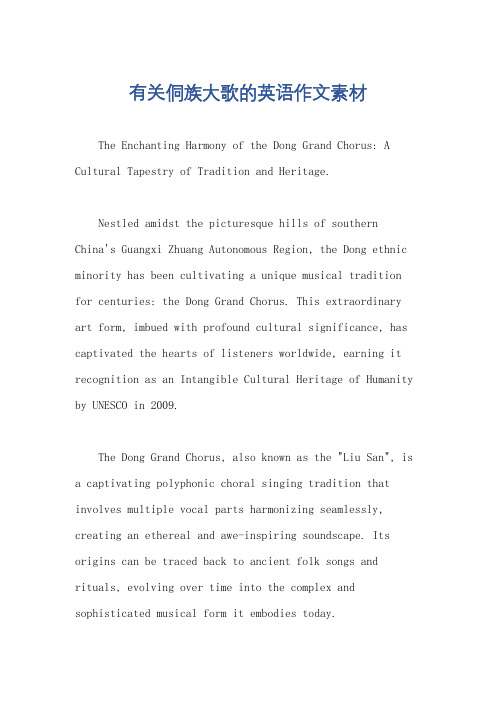
有关侗族大歌的英语作文素材The Enchanting Harmony of the Dong Grand Chorus: A Cultural Tapestry of Tradition and Heritage.Nestled amidst the picturesque hills of southern China's Guangxi Zhuang Autonomous Region, the Dong ethnic minority has been cultivating a unique musical tradition for centuries: the Dong Grand Chorus. This extraordinary art form, imbued with profound cultural significance, has captivated the hearts of listeners worldwide, earning it recognition as an Intangible Cultural Heritage of Humanity by UNESCO in 2009.The Dong Grand Chorus, also known as the "Liu San", is a captivating polyphonic choral singing tradition that involves multiple vocal parts harmonizing seamlessly, creating an ethereal and awe-inspiring soundscape. Its origins can be traced back to ancient folk songs and rituals, evolving over time into the complex and sophisticated musical form it embodies today.Central to the Dong Grand Chorus are its intricate melodies and intricate harmonies. Unlike Western choral music, which typically features a single melody line with accompanying harmonies, the Dong Grand Chorus employs a multi-part structure where each voice represents a distinct melodic line. These melodies interweave and complement each other, creating a rich tapestry of sound that both captivates and mesmerizes.Another distinctive aspect of the Dong Grand Chorus is its use of heterophony, where multiple voices sing slightly different versions of the same melody, resulting in subtle variations in pitch and rhythm. This technique adds depth and texture to the overall soundscape, producing a mesmerizing effect that envelops listeners in a sonic embrace.The lyrics of the Dong Grand Chorus are equally significant, drawing inspiration from Dong folklore, history, and everyday life. These songs narrate tales of love, loss, joy, sorrow, and the daily experiences of theDong people. Through their lyrics, the Dong Grand Chorus serves as a repository of cultural knowledge and a means of preserving the traditions and values of the Dong community.The Dong Grand Chorus is an intergenerational tradition, passed down orally from generation to generation. Young children begin learning the songs at a young age, and as they grow older, they take on more complex roles within the chorus. This process of transmission ensures the continuity of the tradition and safeguards its cultural significance.The performance of the Dong Grand Chorus is a spectacle that transcends mere musicality. It is an immersive experience that engages all the senses. The singers, adorned in traditional Dong attire, gather in a circle,their voices rising and falling in unison, creating a resonant and vibrant atmosphere. The audience istransported to a realm of enchantment, where the boundaries between tradition and modernity dissolve in the ethereal strains of the music.In recent years, the Dong Grand Chorus has gainedincreasing international recognition. It has been featured at prestigious music festivals around the world,captivating audiences with its unique beauty and cultural depth. This exposure has not only raised the profile of the Dong Grand Chorus but has also fostered a greater appreciation for the rich diversity of Chinese musical traditions.However, the Dong Grand Chorus also faces challenges in the face of globalization and modernization. The younger generation, increasingly exposed to Western music and entertainment, may be less inclined to embrace traditional practices. Moreover, the rapid pace of social and economic development in the region could threaten the continuity of the tradition if appropriate measures are not taken to safeguard its preservation.To ensure the long-term vitality of the Dong Grand Chorus, concerted efforts are being made by the Chinese government and cultural organizations to promote and support its preservation. These efforts includeestablishing community choirs, organizing workshops andperformances, and encouraging the development of educational programs that focus on the teaching and传承 of the Dong Grand Chorus.In conclusion, the Dong Grand Chorus is a mesmerizing musical tradition that embodies the cultural identity of the Dong ethnic minority. With its intricate melodies, polyphonic harmonies, and profound lyrics, the Dong Grand Chorus transports listeners to a realm of enchantment, preserving the rich heritage and traditions of the Dong people. As challenges arise in the face of modernity, it is imperative that concerted efforts are made to safeguardthis Intangible Cultural Heritage of Humanity for generations to come. The Dong Grand Chorus stands as a testament to the enduring power of cultural traditions and the vital importance of preserving the diverse tapestry of human expression.。
关于侗族的小作文英语

关于侗族的小作文英语Title: The Enigmatic Culture of the Dong Minority。
Nestled within the lush mountains and winding rivers of southwestern China, the Dong minority, known as the Kam people in their own language, flourishes with a rich cultural tapestry woven through centuries. With a population of over three million, primarily residing in Guizhou, Hunan, and Guangxi provinces, the Dong people have preserved their unique traditions, language, and customs, captivating scholars and travelers alike. In this essay, we delve into the intricate facets of Dong culture, exploring their history, architecture, music, festivals, and contemporary challenges.The history of the Dong people is shrouded in mystery, with oral traditions passed down through generations. According to folklore, their ancestors migrated from the northeastern regions of China over a thousand years ago, seeking refuge in the rugged terrain of the southwest. Theysettled in tight-knit communities, forming villages characterized by their iconic drum towers, wooden houses, and lush rice terraces.Architecture stands as a testament to the Dong's ingenuity and harmonious relationship with nature. The iconic Wind and Rain Bridges, constructed without the use of nails or rivets, symbolize unity and connectivity within Dong villages. These magnificent structures, adorned with intricate carvings and tiled roofs, serve as gathering points for social activities and celebrations.Music occupies a central role in Dong culture, with traditional songs and instruments echoing through the mountains. The lusheng, a type of bamboo pipe instrument, accompanies melodious folk tunes, often sung during agricultural rituals and festive occasions. Polyphonic singing, where multiple voices harmonize simultaneously, showcases the Dong's musical prowess and communal spirit.Festivals constitute a vibrant aspect of Dong life, punctuating the agricultural calendar with colorfulceremonies and rituals. The most renowned festival is the Dong Drum Festival, held annually to celebrate the harvest season and honor ancestral spirits. During this lively event, villagers don traditional attire, engage in drum competitions, and partake in communal feasts, fostering a sense of solidarity and cultural pride.Despite their resilient heritage, the Dong minority faces contemporary challenges in preserving theirtraditions amidst rapid modernization and urbanization. Economic development and government policies have led to the influx of outside influences, threatening the authenticity of Dong culture. Younger generations, lured by urban opportunities, often migrate to cities, leaving behind ancestral villages and cultural practices.To safeguard their cultural legacy, Dong communities have initiated grassroots efforts to promote traditional arts, language education, and eco-tourism initiatives. Cultural centers and heritage sites serve as hubs for preserving ancestral knowledge and fostering intergenerational dialogue. Additionally, collaborationswith researchers and cultural institutions enable the documentation and dissemination of Dong customs to a global audience.In conclusion, the Dong minority embodies a living testament to the resilience and vibrancy of China's diverse ethnic tapestry. Through their distinctive architecture, music, festivals, and communal ethos, the Dong people offer a glimpse into a world steeped in tradition yet evolving with the currents of modernity. As guardians of their cultural heritage, the Dong continue to navigate the delicate balance between preserving the past and embracing the future, ensuring that their legacy endures for generations to come.。
侗族美食英语作文
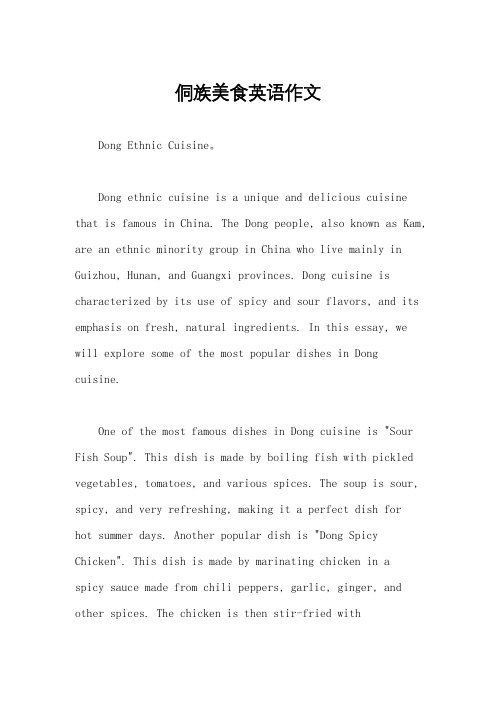
侗族美食英语作文Dong Ethnic Cuisine。
Dong ethnic cuisine is a unique and delicious cuisine that is famous in China. The Dong people, also known as Kam, are an ethnic minority group in China who live mainly in Guizhou, Hunan, and Guangxi provinces. Dong cuisine is characterized by its use of spicy and sour flavors, and its emphasis on fresh, natural ingredients. In this essay, we will explore some of the most popular dishes in Dong cuisine.One of the most famous dishes in Dong cuisine is "Sour Fish Soup". This dish is made by boiling fish with pickled vegetables, tomatoes, and various spices. The soup is sour, spicy, and very refreshing, making it a perfect dish forhot summer days. Another popular dish is "Dong Spicy Chicken". This dish is made by marinating chicken in aspicy sauce made from chili peppers, garlic, ginger, and other spices. The chicken is then stir-fried withvegetables and served hot."Dong Rice Cake" is another popular dish in Dong cuisine. This dish is made by steaming glutinous rice flour mixed with sugar and water. The rice cake is then cut into small pieces and served with a sweet and spicy sauce made from soy sauce, vinegar, chili peppers, and garlic. It is a popular snack in Dong villages and is often served during festivals and celebrations."Dong Bamboo Rice" is a special dish that is unique to the Dong people. This dish is made by stuffing glutinous rice, meat, and vegetables into bamboo tubes and then roasting them over an open fire. The bamboo gives the rice a unique, smoky flavor, and the meat and vegetables add a savory taste to the dish.In addition to these dishes, Dong cuisine also includes a variety of other delicious dishes, such as "Dong Fried Rice", "Dong Sour Soup", and "Dong Stewed Pork". These dishes are all made with fresh, natural ingredients and are cooked using traditional Dong cooking techniques.In conclusion, Dong ethnic cuisine is a unique and delicious cuisine that is famous in China. Its use of spicy and sour flavors, and its emphasis on fresh, natural ingredients, make it a popular cuisine among both locals and tourists. If you ever have the opportunity to try Dong cuisine, be sure to try some of these delicious dishes!。
关于侗族文化的作文340字

关于侗族文化的作文340字英文回答:The Dong ethnic group is one of the ethnic minoritiesin China. They have a rich and unique cultural heritagethat sets them apart from other groups. The Dong peoplehave their own language, which is a branch of the Kam-Tai language family. This language is predominantly spoken in the Guizhou, Hunan, and Guangxi provinces of China.One aspect of Dong culture that stands out is their architecture. The Dong people are known for their drum towers, which are tall wooden structures that serve as a meeting place for the community. These towers are not only functional, but also have intricate designs and carvingsthat showcase the Dong people's craftsmanship. The roofs of the drum towers are made of overlapping wooden tiles, creating a beautiful and unique pattern.Another important aspect of Dong culture is their music.The Dong people are famous for their polyphonic singing, which involves multiple voices singing different melodies simultaneously. This creates a harmonious and melodious sound that is truly captivating. The Dong people also have their own musical instruments, such as the lusheng, a reed-pipe wind instrument, and the suona, a double-reed horn. These instruments are often played during festivals and celebrations, adding to the festive atmosphere.In addition to their architecture and music, the Dong people also have a rich tradition of embroidery. Dong embroidery is known for its intricate patterns and vibrant colors. It is often used to decorate clothing, accessories, and household items. The embroidery patterns often depict nature, animals, and traditional symbols, reflecting the Dong people's close connection with their natural surroundings.The Dong people also have unique festivals and customs that are an integral part of their culture. One example is the "Sister's Meal" festival, which is celebrated by the Dong women to find their life partners. During thisfestival, the Dong women prepare a special meal and offerit to the men they are interested in. If the man acceptsthe meal, it means he is interested in the woman as well. This festival not only showcases the Dong people's unique courtship rituals, but also promotes social interaction and unity within the community.Overall, the Dong ethnic group has a rich and diverse culture that is worth exploring. From their unique architecture and music to their traditional festivals and customs, the Dong people have managed to preserve their cultural heritage throughout the years. It is important to appreciate and respect the cultural diversity of different ethnic groups, as it adds to the richness and beauty of our world.中文回答:侗族是中国的一个少数民族,他们拥有丰富而独特的文化遗产,使他们与其他民族区别开来。
侗族鼓楼文化作文素材

侗族鼓楼文化作文素材英文回答:The Dong Drum Tower culture is a unique and fascinating aspect of the Dong ethnic group in China. The Dong people have a long history and rich cultural heritage, and the Drum Tower is a symbol of their identity and unity.The Drum Tower, or "Gulou" in Chinese, is a tall wooden structure that serves as a communal gathering place for the Dong people. It is usually located in the center of avillage and is used for various purposes, such as ceremonies, performances, and social events. The Drum Tower is also a landmark that can be seen from afar, guiding people back to their village.The Dong people have a strong tradition of music and dance, and the Drum Tower plays a central role in their cultural activities. The tower is equipped with large drums, which are played during festivals and celebrations. Therhythmic beats of the drums create a lively and festive atmosphere, attracting people from all around to join inthe festivities.In addition to music and dance, the Drum Tower is alsoa place for important community meetings and discussions.It serves as a platform for the Dong people to voice their opinions, resolve conflicts, and make collective decisions. It is a symbol of unity and cooperation among the community.The Dong Drum Tower culture is not only about music and gatherings, but also about preserving and passing downtheir traditional customs and values. It is a way for the Dong people to connect with their ancestors and maintain their cultural identity. The Drum Tower is a living testament to the Dong people's resilience and pride intheir heritage.中文回答:侗族鼓楼文化是中国侗族独特而迷人的一部分。
侗族介绍英语作文
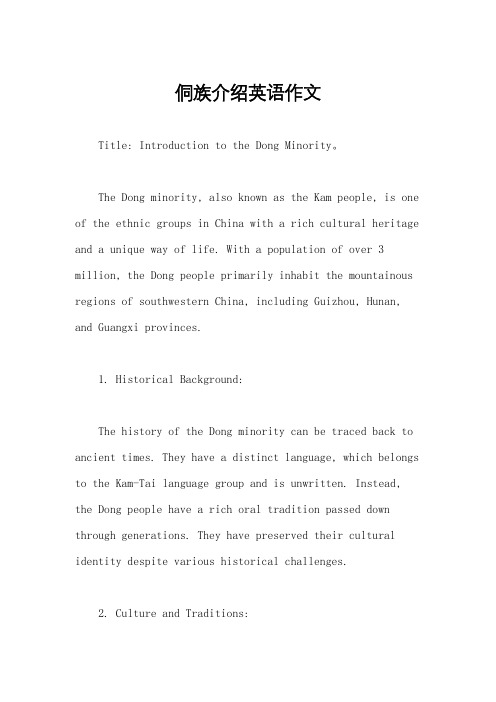
侗族介绍英语作文Title: Introduction to the Dong Minority。
The Dong minority, also known as the Kam people, is one of the ethnic groups in China with a rich cultural heritage and a unique way of life. With a population of over 3 million, the Dong people primarily inhabit the mountainous regions of southwestern China, including Guizhou, Hunan, and Guangxi provinces.1. Historical Background:The history of the Dong minority can be traced back to ancient times. They have a distinct language, which belongs to the Kam-Tai language group and is unwritten. Instead, the Dong people have a rich oral tradition passed down through generations. They have preserved their cultural identity despite various historical challenges.2. Culture and Traditions:The Dong people are renowned for their vibrant culture, characterized by colorful festivals, traditional music, and unique architecture. One of the most notable aspects of Dong culture is their music, particularly their polyphonic choir singing, which has been recognized as a UNESCO Intangible Cultural Heritage. Dong architecture is also distinctive, with the iconic Wind and Rain Bridges being a prominent feature of their villages.3. Clothing and Dress:Traditional Dong attire is both elegant and practical. Women typically wear embroidered, pleated skirts, while men don jackets and trousers made from locally produced textiles. Ornamentation is a significant aspect of Dong dress, with silver jewelry, embroidered patterns, and intricate headwear being common adornments.4. Social Structure and Livelihood:The Dong people traditionally live in wooden stilthouses clustered around a central courtyard. They practice agriculture, cultivating rice, corn, and other crops on terraced fields carved into the mountain slopes. Inaddition to farming, many Dong people are skilled artisans, producing exquisite embroidery, silverware, and bamboo products.5. Festivals and Celebrations:Festivals play a crucial role in Dong society, serving as occasions for community bonding and cultural expression. The most famous Dong festival is the Dong Drum Festival, held annually to celebrate the harvest season. During this festival, villagers gather to enjoy traditional music and dance performances, as well as participate in ritual ceremonies.6. Spirituality and Beliefs:The Dong people adhere to a unique blend of animism, Taoism, and Buddhism. They believe in the importance of maintaining harmony with nature and ancestral spirits.Shamanism also plays a significant role in Dong spirituality, with shamans acting as mediators between the human and spirit worlds.In conclusion, the Dong minority is a fascinating ethnic group with a rich cultural heritage and a deep connection to the natural world. Despite the challenges of modernization, the Dong people continue to preserve and celebrate their unique traditions, ensuring that their cultural legacy endures for future generations.。
侗族美食英语作文
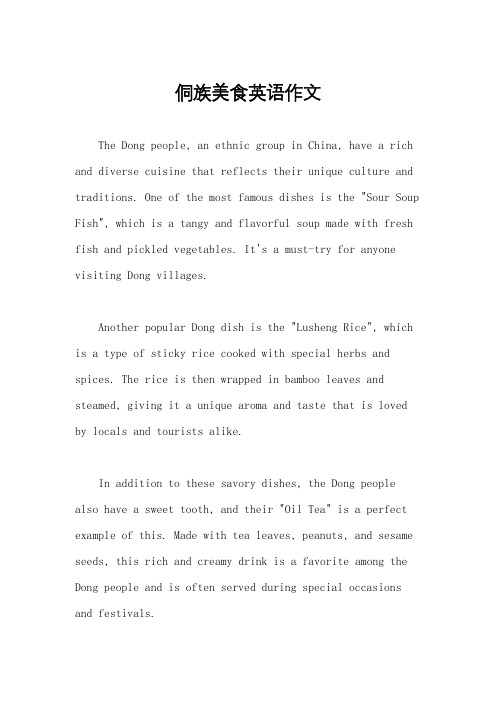
侗族美食英语作文The Dong people, an ethnic group in China, have a rich and diverse cuisine that reflects their unique culture and traditions. One of the most famous dishes is the "Sour Soup Fish", which is a tangy and flavorful soup made with fresh fish and pickled vegetables. It's a must-try for anyone visiting Dong villages.Another popular Dong dish is the "Lusheng Rice", which is a type of sticky rice cooked with special herbs and spices. The rice is then wrapped in bamboo leaves and steamed, giving it a unique aroma and taste that is loved by locals and tourists alike.In addition to these savory dishes, the Dong people also have a sweet tooth, and their "Oil Tea" is a perfect example of this. Made with tea leaves, peanuts, and sesame seeds, this rich and creamy drink is a favorite among the Dong people and is often served during special occasions and festivals.The Dong people also have a variety of snacks andstreet foods that are worth trying. From grilled skewers of meat and vegetables to crispy fried rice cakes, there's something for everyone to enjoy.Overall, the Dong cuisine is a reflection of their vibrant and diverse culture, and anyone who has the opportunity to try it will not be disappointed. So, next time you're in a Dong village, be sure to indulge in their delicious and unique culinary delights.。
侗族的作文
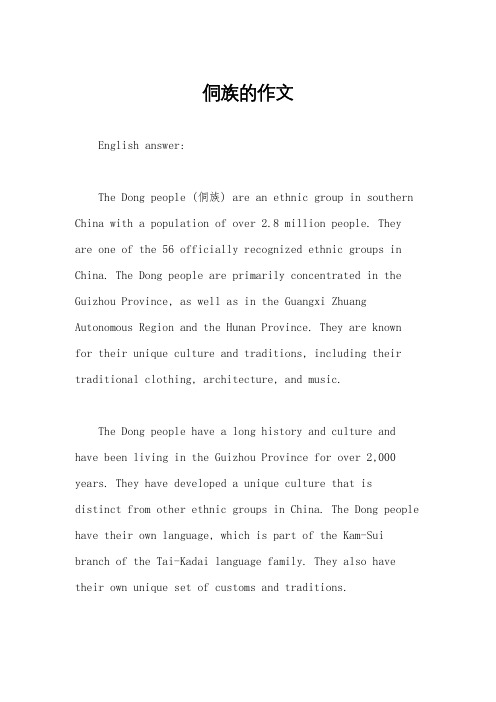
侗族的作文English answer:The Dong people (侗族) are an ethnic group in southern China with a population of over 2.8 million people. They are one of the 56 officially recognized ethnic groups in China. The Dong people are primarily concentrated in the Guizhou Province, as well as in the Guangxi Zhuang Autonomous Region and the Hunan Province. They are knownfor their unique culture and traditions, including their traditional clothing, architecture, and music.The Dong people have a long history and culture and have been living in the Guizhou Province for over 2,000 years. They have developed a unique culture that isdistinct from other ethnic groups in China. The Dong people have their own language, which is part of the Kam-Sui branch of the Tai-Kadai language family. They also have their own unique set of customs and traditions.中文回答:侗族(Dong people)是中国南部的一个少数民族,人口超过280万。
侗族英语介绍
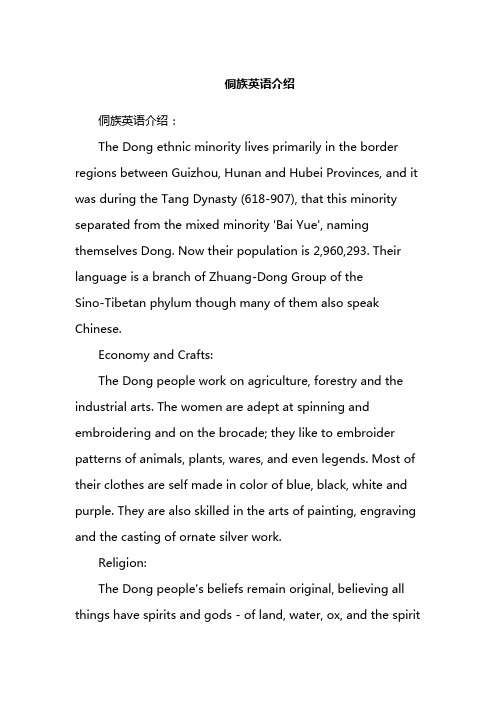
侗族英语介绍侗族英语介绍:The Dong ethnic minority lives primarily in the border regions between Guizhou, Hunan and Hubei Provinces, and it was during the Tang Dynasty (618-907), that this minority separated from the mixed minority 'Bai Yue', naming themselves Dong. Now their population is 2,960,293. Their language is a branch of Zhuang-Dong Group of theSino-Tibetan phylum though many of them also speak Chinese.Economy and Crafts:The Dong people work on agriculture, forestry and the industrial arts. The women are adept at spinning and embroidering and on the brocade; they like to embroider patterns of animals, plants, wares, and even legends. Most of their clothes are self made in color of blue, black, white and purple. They are also skilled in the arts of painting, engraving and the casting of ornate silver work.Religion:The Dong people's beliefs remain original, believing all things have spirits and gods - of land, water, ox, and the spiritof ancestors, etc. Every time there is natural disaster or disease, the Dong people will think devils are responsible and ask a wizard to ward them off.Food:The staple food of the Dong ethnic minority is rice, millet, corn, wheat sorghum and glutinous rice. Oil tea is their favorite drink, which can also be their breakfast, whose ingredients include peanuts, sesame, soybean, tea leaves, and so on. A custom related to it is that, a guest is usually treated to a bowl of oil tea and a single chopstick; when he finishes drinking and does not return the chopstick, hosts will consider the bowl is not enough and replenish the bowl. Dong people also like pickled and acidic foods.Festivals:Like the Han, the Dong has New Year's Day, Mid Autumn Day, and Dragon Boat Festivals along with their own, unique festivals:。
侗族美食英语作文
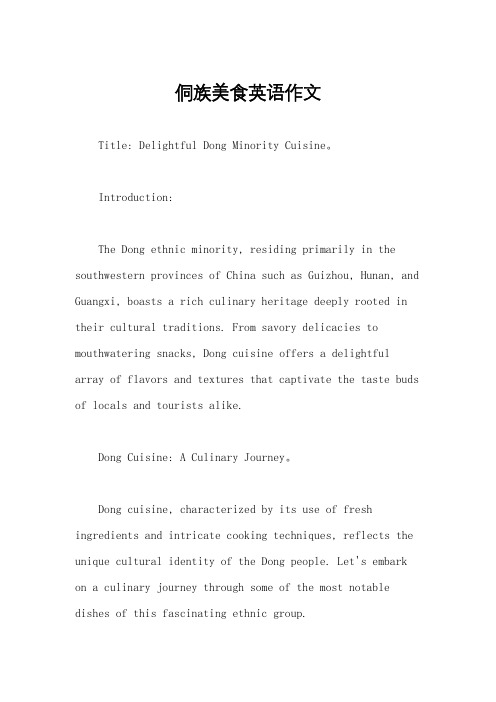
侗族美食英语作文Title: Delightful Dong Minority Cuisine。
Introduction:The Dong ethnic minority, residing primarily in the southwestern provinces of China such as Guizhou, Hunan, and Guangxi, boasts a rich culinary heritage deeply rooted in their cultural traditions. From savory delicacies to mouthwatering snacks, Dong cuisine offers a delightful array of flavors and textures that captivate the taste buds of locals and tourists alike.Dong Cuisine: A Culinary Journey。
Dong cuisine, characterized by its use of fresh ingredients and intricate cooking techniques, reflects the unique cultural identity of the Dong people. Let's embark on a culinary journey through some of the most notable dishes of this fascinating ethnic group.1. Sour Soup Fish (酸汤鱼)。
Sour Soup Fish is a signature dish of Dong cuisine, renowned for its tantalizing sour and spicy flavors. Fresh river fish is simmered in a broth infused with pickledchili peppers, tomatoes, garlic, and various aromatic herbs. The tangy broth perfectly complements the tender flesh of the fish, creating a harmonious balance of flavors that is simply irresistible.2. Bamboo Rice (竹筒饭)。
关于贵州侗族英语的作文

关于贵州侗族英语的作文Here is the English essay about the Dong ethnic group in Guizhou, with the word count exceeding 600 words:The Dong ethnic group in Guizhou, a treasure trove of linguistic diversity, has long captured the attention of linguists and cultural enthusiasts alike. Nestled in the picturesque landscapes of southwestern China, the Dong people have meticulously preserved their unique language, which serves as a testament to the rich tapestry of China's ethnic heritage.Guizhou, a province renowned for its breathtaking natural beauty and cultural mosaic, is home to the Dong ethnic group, one of the largest minority populations in the region. The Dong language, a member of the Tai-Kadai language family, has a complex tonal system and a script that was only recently developed in the 20th century. Despite its relatively small population, the Dong language boasts a rich oral tradition, with intricate folktales, poems, and songs passed down through generations.One of the most remarkable features of the Dong language is its musical quality. The Dong people are renowned for their vocalprowess, with traditional Dong songs often characterized by intricate harmonies and intricate vocal techniques. These songs, which are deeply rooted in the Dong people's cultural identity, serve as a means of storytelling, social cohesion, and spiritual expression.The Dong language is not only a means of communication but also a reflection of the Dong people's deep connection to their natural environment. The language is replete with words and phrases that capture the nuances of the Dong people's agricultural practices, their intimate understanding of the local flora and fauna, and their reverence for the natural world. This linguistic richness serves as a potent reminder of the intimate bond between language and the environment in which it is spoken.Despite the Dong language's rich history and cultural significance, it faces numerous challenges in the modern era. The rapid pace of urbanization and the increasing influence of Mandarin Chinese have put significant pressure on the Dong language, threatening its long-term survival. Many young Dong people, lured by economic opportunities and the promise of a more cosmopolitan lifestyle, are abandoning their native tongue in favor of Mandarin, a trend that has alarmed linguists and cultural preservationists alike.In response to these challenges, the Dong people and their allies have undertaken concerted efforts to revitalize and preserve theirlanguage. Community-based language schools, cultural festivals, and media initiatives have all played a crucial role in keeping the Dong language alive and thriving. These efforts have not only helped to preserve the Dong language but have also fostered a renewed sense of pride and identity among the Dong people.Moreover, the Dong language has drawn the attention of linguists and researchers from around the world, who have recognized its significance as a unique and endangered linguistic treasure. Through collaborative research projects, language documentation initiatives, and academic partnerships, these scholars have helped to shed light on the Dong language's complex history, its linguistic features, and its cultural importance.In conclusion, the Dong language in Guizhou represents a remarkable linguistic and cultural treasure that deserves our attention and support. As the world grapples with the ongoing challenge of preserving endangered languages, the Dong people's efforts to maintain their linguistic heritage serve as a shining example of the power of grassroots activism and community-driven preservation. By celebrating the Dong language and supporting its continued vitality, we can not only honor the rich cultural diversity of China but also contribute to the global effort to safeguard the world's linguistic heritage.。
侗族文化作文600字
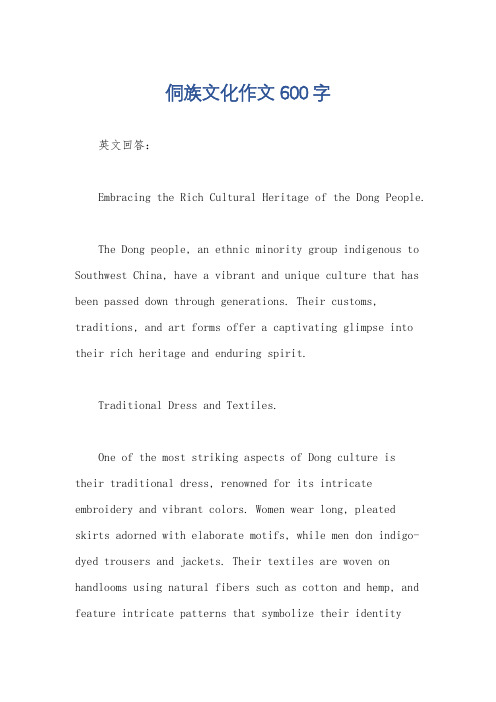
侗族文化作文600字英文回答:Embracing the Rich Cultural Heritage of the Dong People.The Dong people, an ethnic minority group indigenous to Southwest China, have a vibrant and unique culture that has been passed down through generations. Their customs, traditions, and art forms offer a captivating glimpse into their rich heritage and enduring spirit.Traditional Dress and Textiles.One of the most striking aspects of Dong culture istheir traditional dress, renowned for its intricate embroidery and vibrant colors. Women wear long, pleated skirts adorned with elaborate motifs, while men don indigo-dyed trousers and jackets. Their textiles are woven on handlooms using natural fibers such as cotton and hemp, and feature intricate patterns that symbolize their identityand customs.Drum Tower Culture.The drum tower is a central symbol of Dong community life. These towering structures serve as gathering places for festivals, weddings, and other important events. The rhythmic beating of drums resonates through the village, creating a vibrant and festive atmosphere. The Dong people have a profound respect for their drum towers, which are often decorated with elaborate carvings and painted with colorful designs.Music and Dance.Music and dance play a vital role in Dong culture. They have a rich repertoire of traditional songs, ranging from love ballads to work songs. Their dances are characterized by their lively rhythms and graceful movements, often accompanied by the melodic sounds of bamboo flutes and gongs. During festivals, the Dong people perform elaborate dances that showcase their rich cultural heritage.Folklore and Mythology.The Dong people have a rich oral tradition that encompasses folktales, myths, and legends. Their stories often revolve around ancestral spirits, nature, and the origins of their culture. These narratives provide insights into their beliefs, values, and historical experiences. The Dong people also have a strong tradition of storytelling, with elders passing on their knowledge and wisdom to younger generations.Cuisine.Dong cuisine is renowned for its distinctive flavors and use of local ingredients. Their staple foods include glutinous rice, corn, and vegetables, which are often cooked in traditional earthenware pots. One of their most famous dishes is "Sour Fish," a fermented fish dish served with rice. The Dong people also enjoy a variety of soups, stews, and snacks, reflecting their culinary traditions.Embracing the rich cultural heritage of the Dong people provides a profound appreciation for the diversity and richness of China's ethnic minorities. Their traditions,art forms, and beliefs offer a glimpse into a unique and vibrant culture that has stood the test of time.中文回答:侗族文化的传承与发展。
通道侗族风俗550字作文
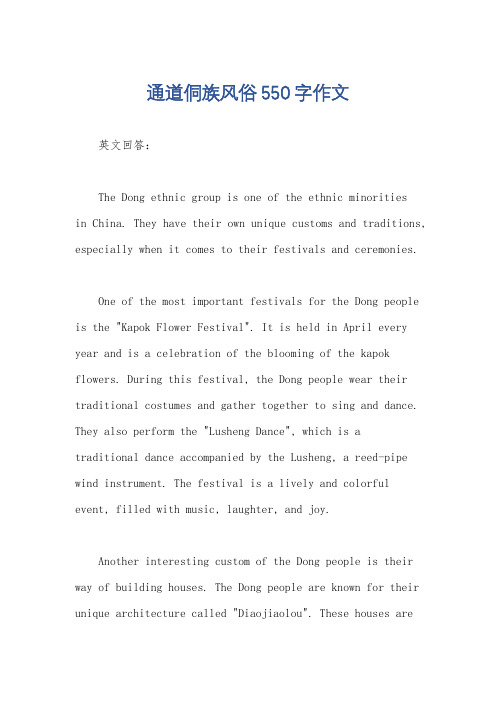
通道侗族风俗550字作文英文回答:The Dong ethnic group is one of the ethnic minoritiesin China. They have their own unique customs and traditions, especially when it comes to their festivals and ceremonies.One of the most important festivals for the Dong people is the "Kapok Flower Festival". It is held in April every year and is a celebration of the blooming of the kapok flowers. During this festival, the Dong people wear their traditional costumes and gather together to sing and dance. They also perform the "Lusheng Dance", which is atraditional dance accompanied by the Lusheng, a reed-pipe wind instrument. The festival is a lively and colorful event, filled with music, laughter, and joy.Another interesting custom of the Dong people is their way of building houses. The Dong people are known for their unique architecture called "Diaojiaolou". These houses arebuilt on stilts and have multiple stories. The first flooris used for raising livestock and storing farm tools, while the upper floors are used for living. The houses are madeof wood and are decorated with intricate carvings and paintings. The Diaojiaolou houses not only serve as residences but also symbolize the unity and harmony of the Dong community.In addition to festivals and architecture, the Dong people also have their own traditional clothing. The women usually wear pleated skirts, embroidered jackets, andsilver accessories, while the men wear loose pants and jackets. The clothing is colorful and vibrant, reflecting the rich cultural heritage of the Dong people.中文回答:侗族是中国的少数民族之一,他们有着自己独特的风俗和传统,尤其是在节日和仪式上。
英语作文介绍侗族
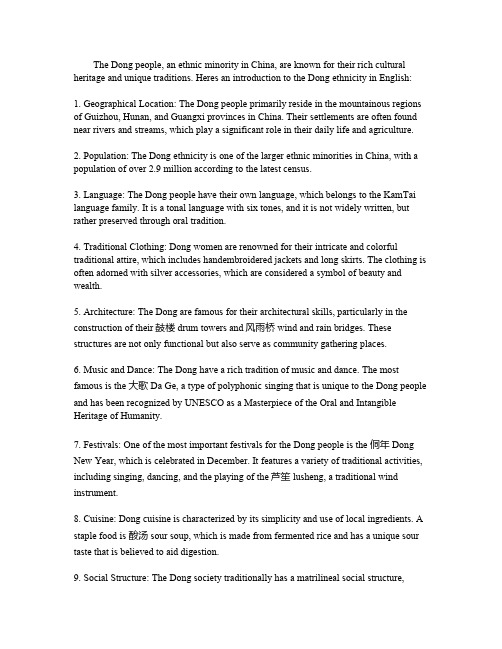
The Dong people,an ethnic minority in China,are known for their rich cultural heritage and unique traditions.Heres an introduction to the Dong ethnicity in English:1.Geographical Location:The Dong people primarily reside in the mountainous regions of Guizhou,Hunan,and Guangxi provinces in China.Their settlements are often found near rivers and streams,which play a significant role in their daily life and agriculture.2.Population:The Dong ethnicity is one of the larger ethnic minorities in China,with a population of over2.9million according to the latest census.nguage:The Dong people have their own language,which belongs to the KamTai language family.It is a tonal language with six tones,and it is not widely written,but rather preserved through oral tradition.4.Traditional Clothing:Dong women are renowned for their intricate and colorful traditional attire,which includes handembroidered jackets and long skirts.The clothing is often adorned with silver accessories,which are considered a symbol of beauty and wealth.5.Architecture:The Dong are famous for their architectural skills,particularly in the construction of their鼓楼drum towers and风雨桥wind and rain bridges.These structures are not only functional but also serve as community gathering places.6.Music and Dance:The Dong have a rich tradition of music and dance.The most famous is the大歌Da Ge,a type of polyphonic singing that is unique to the Dong people and has been recognized by UNESCO as a Masterpiece of the Oral and Intangible Heritage of Humanity.7.Festivals:One of the most important festivals for the Dong people is the侗年Dong New Year,which is celebrated in December.It features a variety of traditional activities, including singing,dancing,and the playing of the芦笙lusheng,a traditional wind instrument.8.Cuisine:Dong cuisine is characterized by its simplicity and use of local ingredients.A staple food is酸汤sour soup,which is made from fermented rice and has a unique sour taste that is believed to aid digestion.9.Social Structure:The Dong society traditionally has a matrilineal social structure,where property and lineage are passed down through the mothers side.However,this practice is less common in modern times.10.Preservation of Culture:Efforts are being made to preserve the Dong culture, including the establishment of cultural villages and the promotion of traditional crafts such as weaving and silversmithing.The Dong peoples culture is a treasure trove of unique traditions and practices that offer a fascinating glimpse into the diversity of ethnic groups in China.Their commitment to preserving their heritage while adapting to modern life is a testament to their resilience and adaptability.。
侗族的作文
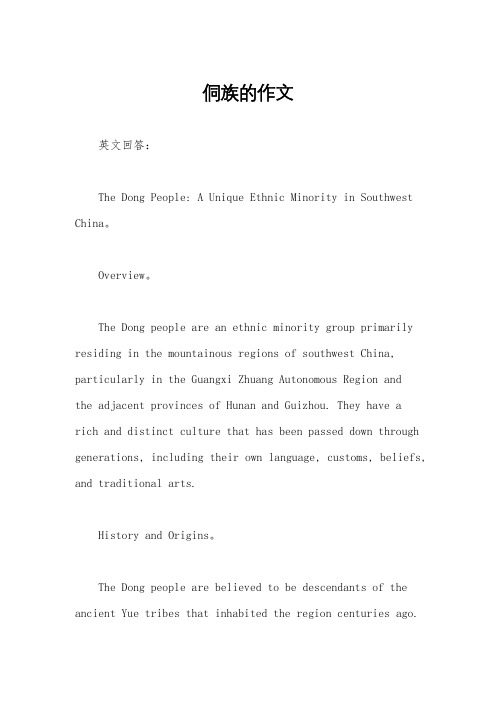
侗族的作文英文回答:The Dong People: A Unique Ethnic Minority in Southwest China。
Overview。
The Dong people are an ethnic minority group primarily residing in the mountainous regions of southwest China, particularly in the Guangxi Zhuang Autonomous Region andthe adjacent provinces of Hunan and Guizhou. They have arich and distinct culture that has been passed down through generations, including their own language, customs, beliefs, and traditional arts.History and Origins。
The Dong people are believed to be descendants of the ancient Yue tribes that inhabited the region centuries ago.They have a unique origin myth involving a celestial bird that guided their ancestors to their current homeland. Over time, the Dong developed their own distinct identity and culture, influenced by both Chinese and neighboring ethnic groups.Demographics and Distribution。
